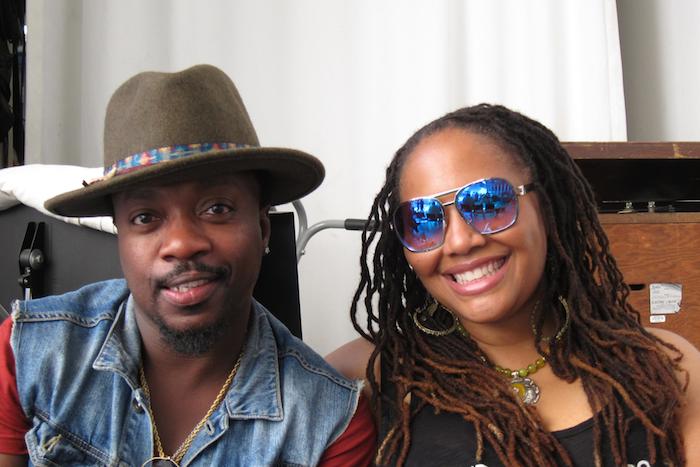
Anthony Hamilton and Lalah Hathaway at the Black Movie Soundtrack tribute at the Hollywood Bowl
I get a call from Lalah Hathaway, who tells me she’s doing a cover of her dad Donnie Hathaway’s classic song “Little Ghetto Boy” and she wants me to appear in the video. I say yes of course. There’s no downside to this. A. I get to be in a music video. B. I get to be in a music video with Lalah Hathaway. C. I get to return the favor for her appearing on several of my projects, like the Black Movie Soundtrack concert at the Hollywood Bowl, and “After All”, a beautiful song on The Ladies Man soundtrack.
Wow, I didn’t know how beloved that song was until I read the comments on YouTube. That’s the second cult classic Marcus Miller has written for one of my soundtracks. The other was from the Boomerang soundtrack as an instrumental cue that folks liked so much they looped it and posted it on line:
Marcus finally turned it into a full song with Raphael Saadiq on vocals.
Back to the video. The other bonus is the video is directed by Ali Leroi, who I’ve known for decades now. I first met him when he was part of Mary Wong, a black high concept comedy team who became part of the Chris Rock comedy brain trust. We worked together on the Everybody Hates Chris pilot, the Are We There Yet? series, and The Shut Your Pie Hole animated digital series, and other stuff I’m probably forgetting and things that never happened, or haven’t happened yet.
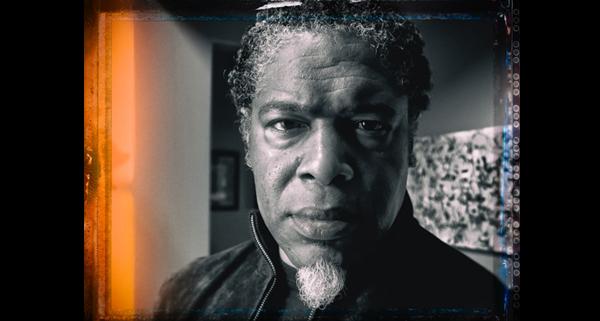
Ali is one of those guys who actually does the stuff I think about doing. He actually learned how to play bass. He has become an amazing photographer. I thought about doing all that. But he did it. I’ve also thought about doing a podcast, but here I am appearing on Ali’s actual podcast.
I ask Ali what am I supposed to do in the video. Am I me or a character? He says I am “meta Reggie”, which is all the explanation I’m going to get, and that’s fine.
I meet them in the parking lot of the church where my children were blessed, and hop in a car with several cameras mounted on it. We drive around listening to the song. Just like everyone else doing a cameo. Finally we just start talking. I make unwanted but nicely tolerated suggestions like adding musical allusions to the songs “The Ghetto” and “The World Is A Ghetto” to the rousing vamp hook at the end. I tell Lalah I do this all the time and how I’m still trying to convince Marcus Miller to do a mash up of Wayne Shorter’s “Pinocchio” and Bootsy Collins’ “Pinocchio Theory”. I play both for her…which led to a shot of me looking down playing with my phone, which somehow made it into the video. “Why are you checking your email daddy?” chastised my daughter, upon seeing the video.
Here’s a behind the scene clip of the making of the video:
What’s great about the video is that it shows hope. The men in the video were little ghetto boys and now they are successful men. Music like her father’s kept us inspired. Lalah continues that mission.
Comment
+ Permalink

By Joseph Philip Illidge, Comic Book Resources
On February 27, 1993, Milestone Media and DC Comics released the first issue of “Hardware” in comic book stores.
Milestone Media, a Black-owned comic book company founded by Denys Cowan, Michael Davis, Dwayne McDuffie, Derek T. Dingle and Christopher Priest, had a publishing partnership with DC Comics.
This partnership allowed DC Comics to lead the way in diversity because Milestone Media published a line of books reflecting a diverse universe of superheroes and villains.
In the last 22 years, Milestone comic books and characters have been in and out of publication, but never out of the comic book fan consciousness.
The relationship between Milestone Media, Inc. and DC Comics has been one of peaks and valleys, and shifts from individual superhero mythologies to shared superhero mythology.
Interestingly enough, the first meeting of the worlds of Milestone and DC took place through a crossover event called “Worlds Collide” in which the Milestone characters fought with, then worked alongside the Superman family of characters, to stop an event that would lead to the destruction of both worlds.
In the most recent cooperative ventures between the two companies, the Milestone characters were established as a part of the DC Universe, most notably in 2011 with the “New 52” initiative that reintroduced the African-American teenage superhero Static Shock to the public, in a monthly series of the same name that lasted eight issues.
That character is at the core of the relationship between the two companies.
Just as Disney purchased the Marvel and Star Wars intellectual properties, companies and characters because, in part, the young male demographic that was elusive to Disney was captured by Marvel and Star Wars, the teenage Black male is a demographic that the DC Universe does not seem to understand.


The company’s heroes later crossed over with DC’s icons in the “Worlds Collide” storyline.
That archetype is not significantly represented in the DC Comics Universe, and the character of Static Shock has appeared in an animated series, a limited series, a one-shot tribute book, various DC Comics titles, and the aforementioned ongoing series since the end of the first “Static” series in 1997.
With all of this, on July 11, 2015, at Comic-Con International in San Diego, arguably the most significant pop culture and entertainment event in the United States for the film, television, and comic book industries, the relaunch of Milestone was clarified with an announcement that the first wave of new titles would happen in conjunction with old publishing partner DC Comics.
Milestone 2.0, founded by original Milestone co-founders Derek T. Dingle and Denys Cowan, and filmmaker and producer Reginald Hudlin, will produce the content that DC comics will publish.
During the Milestone 2.0 panel, a special guest appeared, adding a new layer to the groundbreaking significance of the event.
DC Entertainment’s Chief Creative Officer Geoff Johns.
One would be hard-pressed to find a person more instrumental to the DC Universe and its creative developments over the last decade than Geoff Johns.
Writer of the company’s flagship hero, Superman, along with Batman, The Flash, Green Lantern, and the Titans, all of which have either been translated into cinematic media or will be in the near-future with identified networks, Johns has represented the combination of relative youth and respect for the core mythos and characters that lie at the heart of the DC Comics Universe.
Johns’ presence, his admiration of the Milestone characters and of the Milestone founders, and his announced involvement as writer of an upcoming Milestone project, is symbolic of a new kind of commitment, one unprecedented in the entire history of the Milestone/DC Comics partnership.
That of the creative corporate advocate.


DC launched a “Static Shock” series as part of the New 52, the latest attempt to serve the young Black male demographic
Derek T. Dingle stated at the Milestone panel that the decision to bring the company back in full strength for consistent presence and output was initiated by the death of Milestone Co-founder and Editor-in-chief Dwayne McDuffie.
McDuffie passed away in February of 2011, so this reunion of creative and corporate parties has been in the works for four years.
While the subject of diversity has continued to build in momentum and intensity, this was happening.
The Milestone people were talking and planning with the DC Entertainment people. At the very least, with CCO Geoff Johns and DC Comics Co-Publishers Dan Didio and Jim Lee.
With Johns as the more youthful voice of the three, the one who produced the largest body of creative work revealing his knowledge of the DC Comics mythology and characters, the person who made the historic leap from a vital force in the publishing company to a vital force in the umbrella company encompassing the publisher, the most recent act of his presence at the panel identifies him as the “Superman” of this business equation.
Denys Cowan would be the “Hardware” representative, with his arsenal of visionary skills in which to turn ideas into reality.
Derek T. Dingle, the “Icon”, the business acumen and perspective sitting alongside the creative fictional world of Milestone.
Reggie Hudlin, the “Static”, the newest member of the equation, bringing a new energy and point of view to the company and the cooperative venture.
Hudlin and Johns are the most vocal of the new ingredients to the relationship.
With both men consistently operating in the comic book, television, and film industries, they represent a bridge of worlds and experiences that is at the ethos of the new Milestone 2.0, to expand into different media and increase the exposure of the Milestone characters.


Following the passing of Dwayne McDuffie, one of its founders, Milestone 2.0 has emerged, with Reginald Hudlin coming on board.
The “Static Shock” live-action show, to debut on the Warner Bros. digital platform, and the upcoming “Static Shock” 6-inch figure by DC Collectibles, are unprecedented extensions of the character and license.
The Black teenage male demographic will be captured, and represented in heroic form. Just as Static preceded the teenage Black/Latino Spider-Man by more than a decade and a half, the character will return to reclaim that space as the most relevant reflection of that demographic.
DC Comics, a company unable to match the level of diversity left vacant by the absence of Milestone, despite their various attempts and various characters of color created or re-imagined by DC Entertainment CCO Geoff Johns, will resume the position they held from 1993-1997, as the American superhero comic book publisher with the most focused representation of ethnic and cultural diversity in the business… through the new partnership with Milestone.
Above and beyond the excitement and talent announcements and new art and press releases and panels is that significant point.
The truth of the point is the understanding that the most prevalent narrative of diversity in comic books in the last quarter-century started with Milestone Media, Inc. and no single comic book publisher or combination of comic book publishers has been able to sufficiently replace that narrative.
Milestone will now be poised to reclaim and redefine the narrative.
DC Comics will, once again, be the vehicle of facilitation.


In San Diego, Milestone 2.0 revealed a new partnership with DC Comics, and the latter’s CCO Geoff Johns will write an upcoming project.
Worlds which collided, have united.
There is no better likelihood of success than this, no better social environment open to receive and embrace the Milestone universe than the one in which we now live.
The commitment of Milestone and DC Comics is clear and defined.
If we really want a more diverse fictional world, with creators from different backgrounds writing the stories of characters with different backgrounds, on platforms of global interest and visibility, then nothing should stop us from supporting the fruits of this union.
The quality will provide their commitment.
The sales and loyalty will prove ours.
On February 1993, Milestone Media and DC Comics released the first issue of the Milestone universe of comic books into stores.
I wonder what February 2016 will reveal.
Comment
+ Permalink
Jonah Weiland, Executive Producer/Publisher, Comic Book Resources
Back in January, Milestone Media announced its return, with newcomer Reginald Hudlin now in the mix alongside original co-founders Denys Cowan and Derek Dingle. This new company, Milestone 2.0, announced plans to bring back classic characters from the Milestone stable along with new creations spread across of a variety of outlets and mediums, including a new live-action “Static Shock” series in the works with Warner Bros.’ Blue Ribbon Content shingle. Two of the new company’s principles, Hudlin and Cowan, boarded the world famous CBR Floating Tiki Room at Comic-Con International in San Diego to discuss the company, its new agenda and much more in a lively conversation with CBR TV’s Jonah Weiland.
SDCC: Milestone Media Returns to DC Comics as “Earth-M”
The discussion begins with Hudlin and Cowan examining whether Milestone 2.0 is possibly even more relevant in 2015 than the original company was when it formed in 1993. They also discuss Milestone’s legacy and why its cultural significance has been so pronounced in the years that followed, something both creators credit the animated “Static Shock” with having a hand in.
On whether Milestone 2.0 is even more relevant today than when the original Milestone Media was launched in 1993:
Reginald Hudlin: As a consumer, as a fan, Milestone was hugely impactful. First of all, I’m fans of all these guys individually. I was a huge fan of Denys Cowan’s art; I was a huge fan of Dwayne McDuffie’s writing. So these guys teaming up, them discovering all these other incredible talents, but most of all creating fantastic characters, characters that have what I call “great bones.” Because when you measure comic book characters, you have to look at them in 75 [to] 100-year periods. Is this gonna be a good idea? I mean, like, The Shadow’s a good idea; Batman’s a good idea; Spider-Man’s a good idea. These things last over decades and that’s what struck me about the Milestone creations — Static Shock, Hardware, Icon, and so on and so on, Xombi — is that they had great bones. And then the other thing was that they existed as a company for the top black creators to come together to create the comic book equivalent of Motown. And that’s a big deal.
When we announced 2.0, we thought, “This is a good idea, people want to see this.” It was like, “Oh god, we broke the Internet! What happened?” And it just reminded us, yes, the character is great, but the idea is even greater.
Denys Cowan: Milestone in the ’90s was important, for what it was at that time, and it was great what we did. It called a lot of attention to a lot of things that were going on. Milestone 2.0 is just as important for this time. I can’t say one is more important than the other. I can say they’re both, for their times, right on time, right now. The issues that we’re concerned with — it almost seems that Milestone 2.0 is an amplified version of Milestone, but we’re in amplified times. It feels like even though, when we did it, “Okay, we’re just gonna do this little idea and see if it explodes,” the way it’s been impactful has shown us that, no, this is the right time. We’re doing this at the right time, perhaps the best time to do this company.
On how the “Static Shock” cartoon helped cement the company’s cultural significance:
Cowan: As the audience grew up, we ceased publishing, but they had kids and they taught their kids about Milestone, and the “Static Shock” cartoon was a big thing. We can’t discount that. That was hugely impactful, perhaps more impactful than the comic books themselves because it just reached a lot more people and the same messages — you know Dwayne was a writer on the show, and I was a director and a producer on the show — so we were able to get the same messages across, tell those same Milestone stories to a much bigger audience. So the impact kind of stretched.
Hudlin: And when you think about the audience of kind of Black Saturday morning cartoon shows, usually they were music-based. It was the Jackson 5, it was Hammer Man, it was the Harlem Globetrotters.
Cowan: Mr. T and the T-Force.
Hudlin: “Static Shock” was not a stunt. It wasn’t catching a momentary popularity. It was a legit superhero, with comic books, done by legit comic book creators. In that way, it stood legitimately next to Superman and Batman, and in fact had better ratings than Superman and Batman at the time.
Cowan: Yeah, we were killing in the ratings. But the thing is, it was the same philosophy. Reggie had mentioned this, when we set up the comic books originally, our goal was not to do anything that was fad-ish; not to do anything that was like — except for variant covers, we did that. But we didn’t want to fall into that trap of being so trendy that you’re just out of favor at the next trend. Let’s do solid comic books with solid coloring and solid stories that would stand the test of time. So our emphasis was always on the characters and what we did but not on trends or gimmicks or anything like that.
In the second part of their conversation, Hudlin and Cowan speak to the importance of telling stories accessible to as wide an audience as possible and why the new Milestone books will please new readers and original fans alike. They also discuss the return of writer Christopher Priest, explaining how much they like his work and has crucial he is to both phases of Milestone. Wrapping up, Cowan elaborates on why Milestone 2.0 is much more than just a business move for him.
On whether the Milestone 2.0 stories will fit in canon, function as a reboot, or be something else entirely:
Hudlin: It’s a new starting point because — my philosophy is always ‘something is always someone’s first comic book.’ I’ve got young kids — I’ve got an eight and a ten-year-old — and when they pick up a book and I’ve gotta explain for 15 minutes what’s going on, in a 20-page comic book — that’s not right. When I was a kid you could just pick up the book and know what’s going on. It explained who everybody was, you understood what their interpersonal dynamics were, and you could ride along.
Cowan: Whether you had ever seen it before or not.
Hudlin: I’m a big believer in making a really accessible book. One thing that’s exciting to me when I look at what’s happening today with all kinds of new creators and fans go, “Thank you. All I have to worry about is these six issues. I don’t have to sweat what happened the previous 75 years.
If you were a fan of the original books, you’re gonna love these books. But if you want your son or daughter to get into comics and you want a book that looks like them, or you want your kid to have a more diverse range of reading, this is for you. That’s what’s so great. That’s one of the things we look at and go, “Wow, this is gonna be even bigger this time.” … Kids aren’t hung up about race, they just want the cool thing. We just want to deliver the cool thing.
On whether Christopher Priest will be back in the Milestone fold:
Cowan: We love Christopher Priest.
Hudlin: I’m just gonna say it. So the drive from L.A. to San Diego is like three and a half hours long. I pretty much spent the entire trip talking to Christopher Priest as we were breaking a story. So then I got down here, I go to Denys, “Let me tell you what we’ve been working on.”
Cowan: Except it was at 1 o’clock in the morning. So we’re speaking for an hour at 1 o’clock in the morning. He’s telling me this story. It’s so good we stayed on the phone for an hour just talking about that like, “Dude. And then what happens? And then what happens? And then what happens?” I’m like, “Oh my god, I have to draw this right now.”
Hudlin: It’s so good, it’s so much fun. So then last night I was up, everybody was asleep, I’m like “OK,” because he sent me notes so I got like four different e-mails this morning. I’m like “Aaaaaaah!”
Cowan: To answer the question, yes.
Hudlin: And Christopher Priest, who we love, who we’ve always loved and we’re so happy to be working with him again, he was part of the original team.
Cowan: He was part of the original Milestone. That fifth Beatle that never really gets recognition.
Hudlin: But there’s been so many incredible high-level writers and artists who’ve been like, “What?! Milestone’s back? I’m in! When? Where?” It’s been incredible. The biggest names in the business are like, “We are down. We wanna be in.” We’re super excited about the amount of firepower we’re gonna bring.”
On what has Cowan so excited about the return and future of Milestone:
Cowan: It’s very simple. When we talk about Milestone and you said, “Well, first of all it’s a business.” And I’m thinking to myself, my first thing is, “I have to interrupt my man.” ‘Cause it’s not just a business, it’s a cause. It’s a mission. To me there is no — I feel intense about Milestone and the characters we do because to me there is no greater thing to do than to do something for our fans in this medium with these characters. That’s it for me. I’d be very happy if this is all I worked on for the rest of my career; doing these characters and doing it for this audience that I love.
Comment
+ Permalink
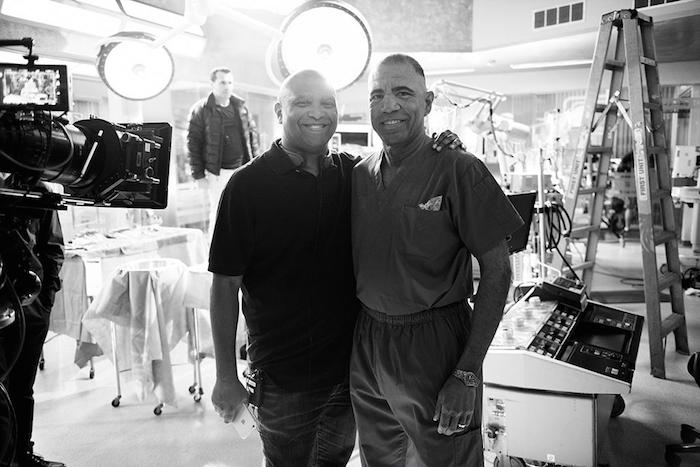
Or “Doctor Chris”, as we call him at our house, to distinguish him from “Uncle Chris” aka my brother.
He’s a surgeon, which automatically makes him that family member you treasure because he’s the one you call to get a second opinion on your every ache and pain.
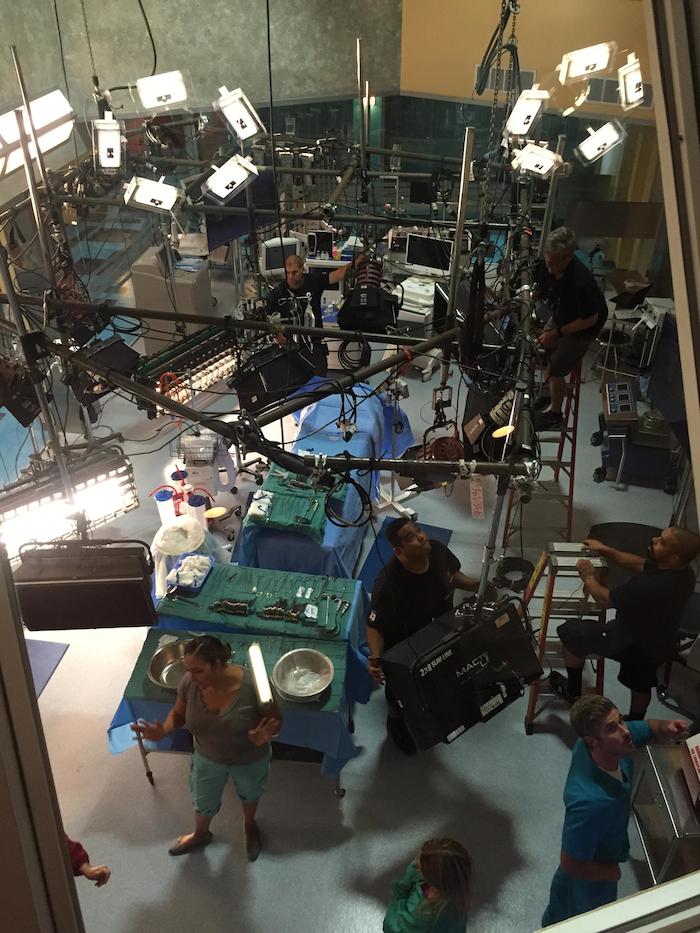
While I was shooting HEARTBREAKER, a new medical show for NBC, I invited him down to visit me on set, which he had never done before.

Since he had actually performed the liver transplant we were shooting, he ended up on camera, helping us all make the scene more realistic.
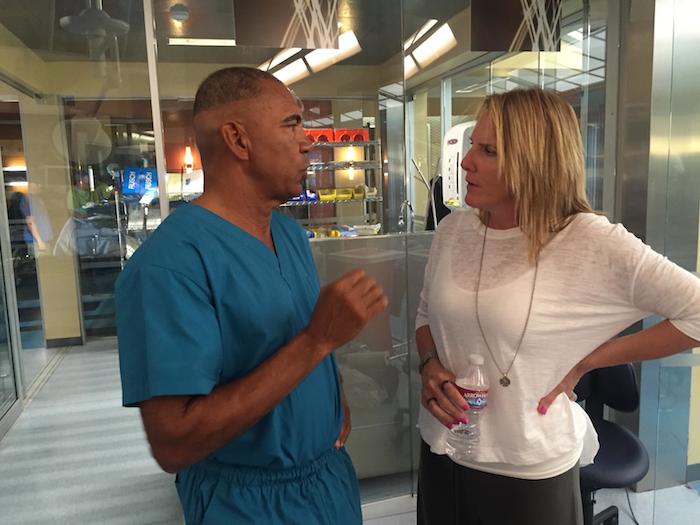
Dr. Kathy Magliato, the doctor whose book is the basis of the show, loved having him on set and they happily talked in a medical jargon far over my head.
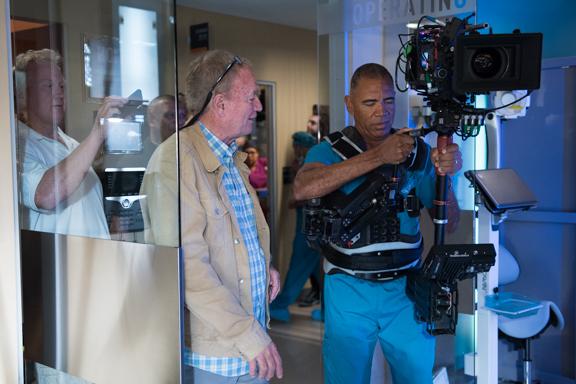
The entire cast and crew loved him, including the camera operators who invited him to try out the steadicam. Even with the monstrous weight, he took to it quicker and easier than any of us had ever seen.
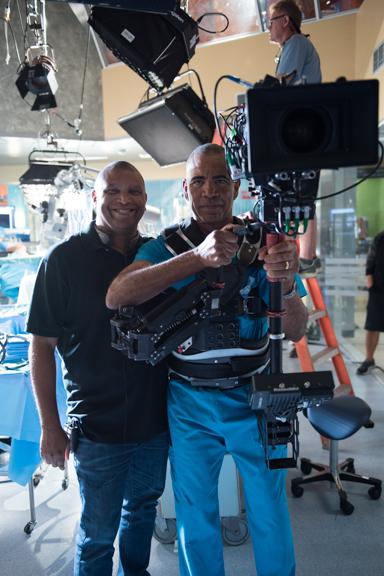
Comment
+ Permalink

















